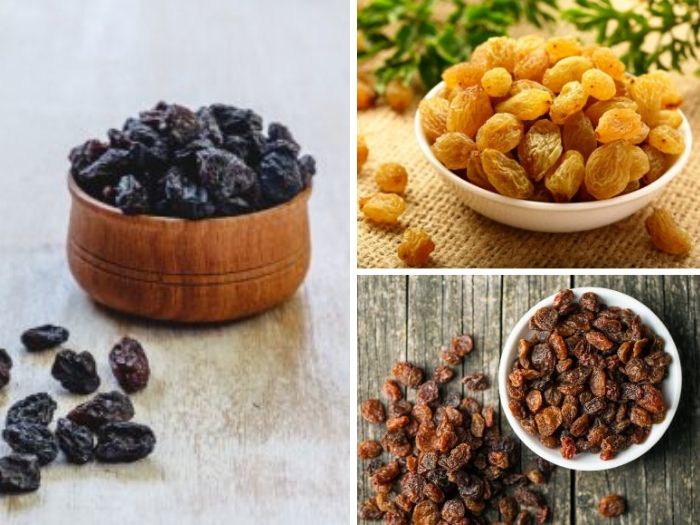They are deliciously sweet and moist in texture and are incredibly versatile in the kitchen. We are talking about sultanas, raisins, and currants that are different types of dried fruits, more specifically dried grapes, which you find in several dishes right from your oatmeal, salads, to your favorite desserts. They may be packed with more or less the same kind of vitamins, minerals, and antioxidants but still have attributes that make them different from one another. What are they, you ask? Let us find out.
Raisins vs Sultanas vs Currants
Raisins, sultanas, and currants are different kinds of dried grapes. Although subtle, their differences mainly lie in their taste, texture, and color. Understanding what makes them distinct from each other can be a bit confusing given that they mean different things in different parts of the world. In most parts of the world, particularly in the United States of America raisins, and sultanas are both the same thing – raisins. The only way you can distinguish one from another is by their color. Sultanas are known as golden raisins. However, in other parts of the world, the type of grape and processing method used is what differentiates a raisin from a sultana. Currants, on the other hand, are obtained by drying a variety of grapes known as Black Corinth, which are a particular variety of small, seedless grapes.

Raisins, sultanas, and currants are all popular and different types of dried grapes. Photo Credit: Shutterstock
Raisins
- How are they made?: Produced from a range of grapes varieties, raisins are made by either traditionally sun-drying the grapes or by artificially dehydrating them. These varieties include Moscatel, Thompson seedless, Muscat, Lexia, and Waltham Cross, which are predominantly produced in the US, Turkey, Australia, and Greece. [1]
- Color: Usually, raisins are dark in color and soft and are larger when compared to sultanas and currants.
- Texture: They are chewy and have a wrinkled texture.
- Taste: They are naturally sweet. While baking, sometimes raisins are soaked in liquors like rum, brandy, or almond-flavored Amaretto, which further enhances its flavor.
Sultanas
- How are they made?: Sultanas are made from green seedless grapes. They are mainly produced in Turkey. However, the most common type of grapes in the US that are used to make sultanas are the Thomson seedless variety. These take a longer time to dry- nearly three weeks.
- Color: They are dried seedless white grapes, which are often known as golden raisins because of their color that sets them apart from the rest. They owe their light color to the oil-based solution that is typically applied to the grapes before the drying process. It is also the preservative, sulfur dioxide that’s added to them during this process that gives them the light golden color. [2]
- Texture: They are plumper and juicier than raisins and currants.
- Taste: They are sweeter than raisins and currants.
Currants
- How are they made?: Currants are made by drying a variety of grapes known as Black Corinth and Carina, which are small, seedless grapes. Originally cultivated in the south of Greece, particularly in the island of Zante, which has given it its name, Zante currants. They are dried for nearly three weeks.
- Color: They are dark red.
- Texture: They have a lovely chewy texture.
- Taste: They have a sweet and intense tangy flavor and are usually used in traditional cakes and several savory dishes.
Are They Really That Different?
Sultanas, raisins, and currants, despite their differences in appearance, taste, and texture, have more or less the same nutrition profile. After grapes undergo the drying process, they shrink in size and what you get is a nutrient-dense dried fruit that has more vitamins, minerals, fiber, and electrolytes than normal grapes. According to the data provided by the Australian government on dry fruits, the nutrient variations between each of the three is minuscule. The natural sugar content in each of them is quite high and lies between 60 to 75 %, which means they need to be consumed in moderate quantities. The data also suggests how each of them is rich in potassium and fiber and is a great source of antioxidants. [3] [4] [5] [6]
They are incredibly versatile in the kitchen and can be used in a plethora of dishes right from oatmeal, snacks, baked delicacies, salads, and savory dishes. When not using them, they need to be stored in a cool, dry, and dark place as direct sunlight can cause it to further dry out. If you wish to keep them for a longer duration, it is advisable to transfer it in an airtight container or a freezer bag and refrigerate.
